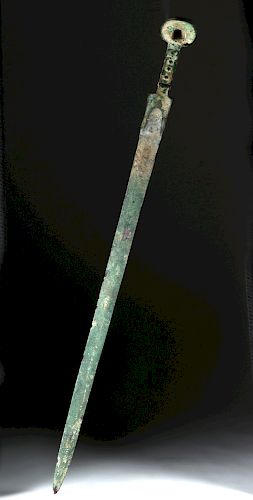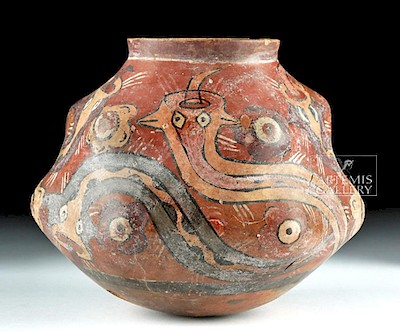Fine Luristan Bronze Double-Ear Pommel Sword - 32"L
Lot 81
About Seller
Artemis Gallery
686 S Taylor Ave, Ste 106
Louisville, CO 80027
United States
Selling antiquities, ancient and ethnographic art online since 1993, Artemis Gallery specializes in Classical Antiquities (Egyptian, Greek, Roman, Near Eastern), Asian, Pre-Columbian, African / Tribal / Oceanographic art. Our extensive inventory includes pottery, stone, metal, wood, glass and textil...Read more
Categories
Estimate:
$3,800 - $5,700
Absentee vs Live bid
Two ways to bid:
- Leave a max absentee bid and the platform will bid on your behalf up to your maximum bid during the live auction.
- Bid live during the auction and your bids will be submitted real-time to the auctioneer.
Bid Increments
| Price | Bid Increment |
|---|---|
| $0 | $25 |
| $300 | $50 |
| $1,000 | $100 |
| $2,000 | $250 |
| $5,000 | $500 |
| $10,000 | $1,000 |
| $20,000 | $2,500 |
| $50,000 | $5,000 |
| $100,000 | $10,000 |
| $200,000 | $20,000 |
About Auction
By Artemis Gallery
Jul 5, 2018
Set Reminder
2018-07-05 10:00:00
2018-07-05 10:00:00
America/New_York
Bidsquare
Bidsquare : Ancient | Ethnographic | Fine Art
https://www.bidsquare.com/auctions/artemis-gallery/ancient-ethnographic-fine-art-3306
Featuring classical antiquities, ancient and ethnographic art from cultures encompassing the globe. Artemis Gallery info@artemisgallery.com
Featuring classical antiquities, ancient and ethnographic art from cultures encompassing the globe. Artemis Gallery info@artemisgallery.com
- Lot Description
Ancient Near East, northwestern Iran, Luristan, ca. 1200 to 800 BCE. A magnificent and enormous bronze sword of the "double ear" pommel style, made by highly trained urban artisans, using the lost wax (cire perdue) casting technique, for an elite member of a nomadic horse-riding clan. The blade was cast first, and then the handle was cast onto it - scans of similar swords have revealed tangs inside the handles. Gorgeous verdant green patina envelops the entirety of the weapon, with miniscule areas of azurite patina inside of pommel ears. Size: 4.375" W x 32.25" H (11.1 cm x 81.9 cm).
This well-balanced weapon has a slender, square hilt, with raised decorative elements on each of the four sides joining to a pommel that divides into two finely decorated semi-circular "ears" at right angles to the blade. A rectangular guard carefully designed with crescent-shaped horns extends down to firmly grip the upper end of the prominent midrib that tapers regularly with almost straight cutting edges to a point.
The "double ear" style of sword - with both bronze and iron blades - has been excavated from graves in southern Azerbaijan, the Talish and Dailaman regions of northwest Iran, and the urban sites of Geoy Tepe and Hasanlu, also in northwestern Iran. Another, with both bronze pommel and blade, was pulled from the Caspian Sea, where it may have been thrown as an offering.
It seems that swords like this were not just made to be used in battle, but instead to show status or as votive weapons. There is a strong tradition in the ancient Near East of swords and other weapons being associated with the gods. For example, a rock carving dating to ca. 1300 BCE from this region shows a scene of the gods of the Underworld, including one who is holding a sword similar to this one. Similarly, a golden bowl excavated at Hasanlu (northwestern Iran) shows three swords of similar form to this one that are associated with three deities from the Hittite pantheon. Whatever its original function, this would have been a spectacular weapon to behold, with a deep, shining surface when polished. Whoever commissioned this sword must have been a high status individual, perhaps seeking to honor their gods by handling such a weapon.
The British Museum has an example of the "double ear" style that is similarly in size to this one (ME 124630): http://www.britishmuseum.org/research/collection_online/collection_object_details/collection_image_gallery.aspx?partid=1&assetid=263419001&objectid=367539
Provenance: private Davis Collection, Houston, Texas, USA
All items legal to buy/sell under U.S. Statute covering cultural patrimony Code 2600, CHAPTER 14, and are guaranteed to be as described or your money back.
A Certificate of Authenticity will accompany all winning bids.
We ship worldwide and handle all shipping in-house for your convenience.
#132932Small losses to blade tip, edges, faces especially near guard, fading to some details, and slight bending to overall form, otherwise excellent. Nice earthen deposits and lovely green patina throughout with small areas of azurite patina as well.Condition
- Shipping Info
-
All shipping is handled in-house for your convenience. Your invoice from Artemis Gallery will include shipping calculation instructions. If in doubt, please inquire BEFORE bidding for estimated shipping costs for individual items.
-
- Buyer's Premium



 EUR
EUR CAD
CAD AUD
AUD GBP
GBP MXN
MXN HKD
HKD CNY
CNY MYR
MYR SEK
SEK SGD
SGD CHF
CHF THB
THB


















